Key Concepts
The low-density outermost layer of the Earth above the Mohorovičić discontinuity (the Moho), a global boundary that is defined as the depth in the Earth where the compressional-wave seismic velocity increases rapidly or discontinuously to a value in excess of 7.6 km/s (4.7 mi/s; the upper mantle). The crust is also the cold, upper portion of the Earth's lithosphere, which in terms of plate tectonics is the mobile, outer layer that is underlain by the hot, convecting asthenosphere. See also: Asthenosphere; Lithosphere; Moho (Mohorovicic discontinuity); Plate tectonics
Continental crust
The Earth's continental crust has evolved over the past 4 billion years, and is highly variable in geologic composition and internal structure. The worldwide mean thickness of the continental crust is 40 km (24 mi), with a standard deviation of 9 km (5.4 mi; Fig. 1). The thinnest continental crust (found in the Afar Triangle, northeast Africa) is about 15 km (9 mi) thick, and the thickest (the Himalayan Mountains in China) is about 75 km (47 mi) thick. Ninety-five percent of all continental crust has a thickness within two standard deviations of the mean thickness, between 22 km (13 mi) and 58 km (37 mi). The Antarctic has a crustal thickness of 40 km (24 mi) in the ancient, stable (cratonic) region of East Antarctica, and about 12 mi (20 km) in the recently stretched (extended) crust of West Antarctica. Continental margins, which mark the transition from oceanic to continental crust, range in thickness from about 15 km (9 mi) to 30 km (18 mi). See also: Continental margin
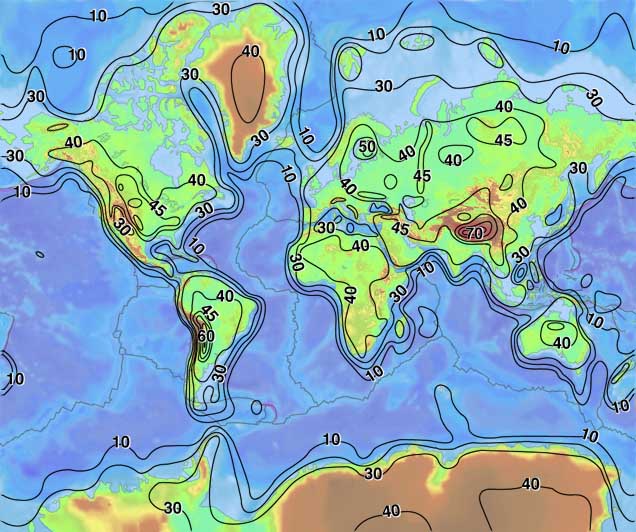
Seismic refraction profiles
The internal structure of the crust reveals much about crustal evolution, and one effective way of describing this structure is based on the results of seismic refraction profiles that define crustal layers (that is, layers with characteristic compressional-wave seismic velocity). This seismological method for investigating the crust is widely used for two reasons: seismic refraction measurements are made on a global basis, and the seismically defined layers correspond to geologic layers. There is a relationship between the compressional-wave seismic velocity, density, and rock composition for coarse-grained igneous rocks (Fig. 2). Seismic reflection profiles can be used to relate seismic velocities to crustal composition and density. A composite crustal section can be deduced from these data. See also: Seismology
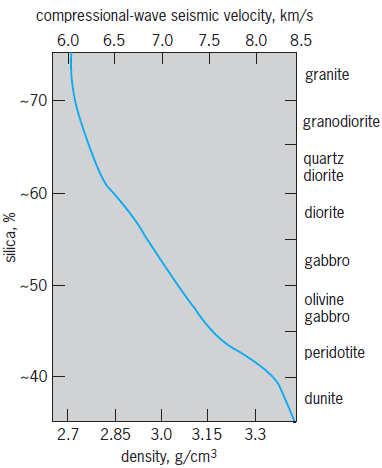
Despite its geologic complexity, the continental crust may generally be divided into four layers: an uppermost sedimentary layer, and an upper, middle, and lower crust composed of crystalline rocks. The sedimentary cover of the continental crust is an important source of natural resources. This cover averages 1 km (0.6 mi) in thickness, and varies from 0 (for example, on shields) to more than 15 km (9 mi) in deep basins. In stable continental crust of average thickness (40 km or 25 mi), the crystalline upper crust is commonly 10–15 km (6–9 mi) thick and has an average composition equivalent to a granite. The middle crust is 5–15 km (3–9 mi) thick and has a composition equivalent to a diorite; and the lower crust is 5–20 km (3–12 mi) thick and has a composition equivalent to a gabbro. Owing to increasing temperature and pressure with depth, the metamorphic grade of rocks increases with depth, and the rocks within the deep continental crust generally are metamorphic rocks, even if they originated as sedimentary or igneous rocks (Fig. 3). See also: Diorite; Gabbro; Granite; Metamorphic rocks
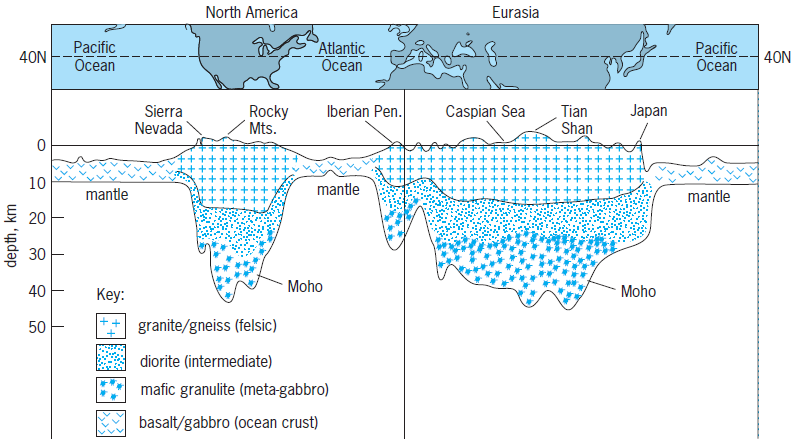
Crustal properties vary systematically with geologic setting, which may be divided into seven groups: orogens (mountain belts), shields and platforms, island arcs (volcanic arcs), continental magmatic arcs, rifts, extended (stretched) crust, and forearcs (Fig. 4). Orogens are typified by thick crust [average thickness is 46 km (29 mi), but the maximum thickness is as much as 75 km (47 mi) in the Himalayas of Asia and Andes of South America]. The seismic structure of orogens is highly variable and is related to the nature of the orogen (for example, continent-continent collision versus ocean-continent collision). However, a thick upper crustal layer is common, and this is the result of thickening of the upper crustal section by wedging and stacking of the compressed upper crust. Shields and platforms, such as the Canadian Shield and the Russian Platform, commonly have an approximately 42-km-thick (26-mi) crust, including a 5–10-km-thick (3–6-mi) high-velocity (7.1–7.5-km/s or 4.4–4.7-mi/s) lower crust. In comparison with shields, island arcs (such as Japan) have thinner crusts and significantly shallower middle and lower crustal layers due to the intrusion of mafic (that is, low silica content) plutons. Continental magmatic arcs, such as the Cascades volcanoes of the northwestern United States, intrude preexisting continental crust, and therefore they are generally 10–15 km (3–9 mi) thicker than island arcs. Continental rifts, such as the East African and Rio Grande rifts, have an average crustal thickness of about 36 km (22 mi), but show great variability in seismic structure. Extended continental crust, such as the Basin and Range Province of the western United States, averages 18 mi (30 km) in thickness, and has relatively little high-velocity (greater than 6.8 km/s or 4.2 mi/s) crustal material. Forearcs are regions that were formed by the coast, near volcanic arcs, including much of the west coast of North America. They typically have thin crust, about 25 km (15 mi), and have a thick (15 km or 9 mi) upper crustal section that consists of relatively low-density metasedimentary rocks. See also: North America; Oceanic islands; Pluton; Rift valley; Sedimentary rocks; Volcano
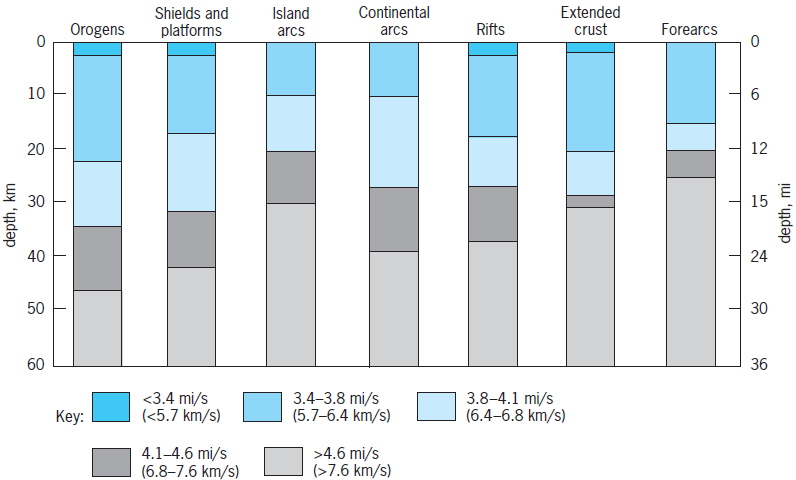
Seismic reflection profiles
Seismic reflection profiles use vertically traveling waves to obtain a high-resolution image of the crust, whereas refraction profiles use horizontally traveling waves to obtain seismic velocity information. Reflection profiles provide images of the deep crust that may be interrupted in terms of lithologic, metamorphic, and porosity layering, dipping fault zones, and (more rarely) the presence of crustal melts. Distinct reflection patterns that correlate with geologic setting can also be identified. These patterns provide important information on how the crust has been formed and modified. In many regions, particularly in extended crust, the lower crust contains numerous horizontal reflections that terminate at the depth of the Moho. These reflections are most likely the result of igneous intrusions into the lower crust, combined with horizontal stretching of the warm and ductile lower crust. See also: Igneous rocks
Seismic reflection profiles across mountain belts (orogens) show near-horizontal sheets of rock (nappes) in zones of crustal thickening and deformation. These upper crustal nappes can be followed to midcrustal levels in the Alps, and what has been termed thin-skin tectonics [the horizontal transport of 5–10-km-thick (3–6-mi) sheets of upper crustal material over large distances] has been confirmed in the Appalachians of the eastern United States and in western Europe. See also: Cordilleran belt; Mountain systems
Seismic reflection profiles in Precambrian crust show pronounced, widespread structural features dating from that period, indicating long-term thermal and mechanical stability. It is possible that the geometry of these structures is qualitatively consistent with plate tectonic processes operating 2 billion years ago. See also: Precambrian; Seismology
Geoelectrical measurements
Measurements of electrical conductivity within the deep continental crust have revealed high conductivities at midcrustal depths that provide important information on crustal properties. High crustal conductivity can be caused by several factors, including the presence of saline fluids, partial melts, sulfide minerals, or carbon films. In regions of high heat flow, such as actively extending crust, high crustal conductivities are often found at midcrustal depths (10–20 km or 6–12 mi), and may indicate the melting of wet granitic rocks or the presence of fluids produced by metamorphic dehydration reactions. In young mountain belts, such as the Carpathian Mountains of eastern Europe and the Alaska Range of central Alaska, dipping high-conductivity zones can be correlated with large carbon-rich flysch and black shale basins that have been crushed and deeply buried during the mountain-building process. See also: Black shale; Geoelectricity; Orogeny; Turbidite
Continental crustal evolution
The properties of the continental crust provide important constraints on the process of crustal evolution. The continents coalesce and disperse as ocean basins open and close, and continental crust is deformed and modified during rifting and at ocean-continent and continent-continent collisions. A net increase in the total volume of continental crust requires extraction of crustal material from the mantle and the stabilization of this material within a continental block.
At least three processes provide new continental crust. The first is the accretion and consolidation of island arcs, such as Japan or the Aleutian Islands, onto a continental margin. The second process is the tectonic underplating of oceanic crust at active subduction zones. In this process, the continental crust grows from below as oceanic crust is welded to the base of the continental margin, either when subduction stops or when subduction steps oceanward and a new trench is formed. This process has been identified in western Canada and southern Alaska. The third process is the magmatic inflation of the crust at continental arcs, rifts, and regions of crustal extension. This process has been identified in many regions. See also: Geodynamics
Although both the accretion of island arcs and tectonic underplating of oceanic crust can be documented as stages of continental growth, these processes by themselves would result in a bulk crustal composition that is more mafic (low silica content) than the actual bulk composition of continental crust. This apparent discrepancy can be resolved in at least two ways. First, the mafic lower crust of some island arcs may be delaminated (peeled off from below) and subducted back into the mantle, thereby leaving the remaining crust less mafic. Second, an originally thick mafic lower crust may undergo secondary differentiation that produces an intermediate composition melt and a mafic-ultramafic residue (restite), which ponds at the base of the crust. After cooling, the restite would have a seismic velocity of about 8 km/s (5 mi/s) and therefore would constitute a new, shallower seismic Moho with a less dense, less mafic overlying crust.
Oceanic crust
The surface of the ocean crust, except for some locally high volcanoes and plateaus, resides some 2–5 km (1–3 mi) below sea level, approximately 3–6 km below the average level of the continents. While the continental crust consists mainly of ancient mountain belts, with an average age of 1500 million years ago (MYA), oceanic crust is relatively young and dynamic, having a maximum age of only 200 MYA. Most of it was produced at mid-ocean ridges during seafloor spreading, where ridges define the accreting boundaries of major lithospheric plates moving about the surface of the Earth. Thus, the oldest rocks of the ocean crust date back no earlier than the rifting episodes that initiated the most recent phase of continental drift (the Pangaean breakup) in Late Jurassic times. See also: Jurassic; Mid-Oceanic Ridge
Seafloor spreading
The seafloor spreading mechanism holds that the ocean basins, for example the Atlantic and Indian oceans, developed after continental rifting. During seafloor spreading, magmatic upwelling at the central mid-ocean ridge repeatedly introduces new basaltic crust along a narrow median rift, in the center of a basin within a global system of underwater mountains. This system of mountains, which is more than 20,000 km (12,000 mi) long, is interconnected through all the major ocean basins, including the Pacific and Arctic basins. It has been determined that this process of rifting, basaltic magmatism, and continued seafloor spreading has produced the vast majority of ocean crust (Fig. 5). The rates of plate motions are deduced from the records of Earth's magnetic reversals preserved in the basaltic rocks surrounding ocean ridges. While magnetic domains in liquid magma will rotate according to the Earth's magnetic field, once lava solidifies, the orientation of material is no longer flexible and the basalt will “freeze,” reflecting the direction of the Earth's magnetic field at its time of emplacement. The anomalies, which are mapped with magnetometers towed from ships, document the shifting patterns of plate motion in the ocean basins, as well as the history of seafloor spreading. They demonstrate that the ocean crust is one vast, approximately 6-km-thick (4-mi) basaltic lava field covering nearly 70% of the Earth's surface. See also: Basalt; Basin; Continental drift; Convection in the Earth; Lava; Magma; Magnetometer; Rock magnetism
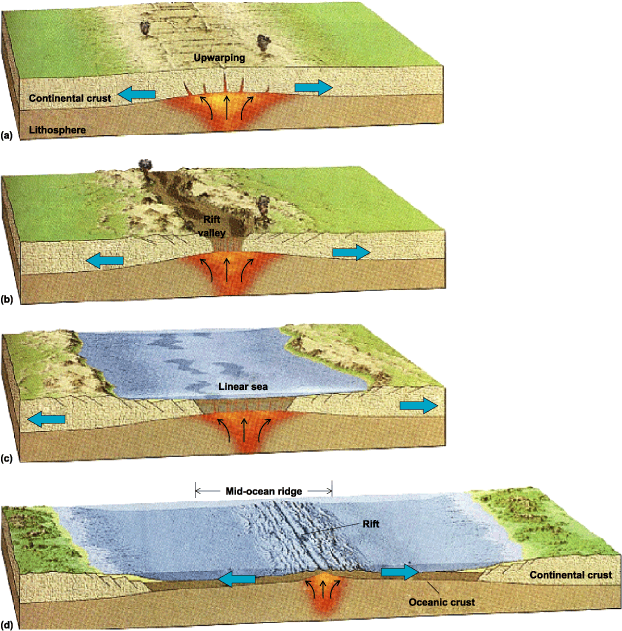
The extent of this lava field and its fundamental basaltic composition have been documented by extensive dredge sampling programs along active ridges, the transform faults that offset them, and the fracture-zone scars that trail far off onto the flanks of the ridges. The older portions of the ocean crust have been sampled in dozens of localities by drilling through a carapace of mainly biogenic marine sediments. In all cases, the continuity of the spreading process has been confirmed. Thus, emplacement of basalt at mid-ocean ridges is the universal mechanism by which ocean crust is formed. See also: Marine sediments; Transform fault
Characteristics
The base of the ocean crust is defined by the location of the seismic Moho. The Moho is usually an abrupt transition between rocks with average seismic velocities of about 6.7 km/s (4.2 mi/s) to rocks with velocities of about 8 km/s (5 mi/s). The former velocities agree with experimental determinations on varieties of nonporous mafic rocks including gabbros and amphibolites (rocks that have significant proportions of plagioclase and little olivine), whereas the latter velocities can represent only nearly fresh (nonserpentinized) peridotite, consisting mainly of olivine and pyroxenes with virtually no plagioclase. In the oceans, explosion seismology and seismic reflection carried out from ships are used to determine both the location of the Moho and the structure of the overlying crust. Both gabbros and serpentinized peridotites are present at various tectonic exposures in the ocean crust, such as along fracture zones, the walls of median rifts, and low-angle detachment surfaces in the floors of rifts. Thus, it is likely that gabbros are the rocks of the lower ocean crust that overlie mantle peridotites. However, there is no known place in the ocean basins where a coherent crust-mantle transition is exposed in outcrop. See also: Amphibolite; Peridotite
There are fault slices of former ocean crust on land, known as ophiolites, where nearly complete cross sections through the crust can be mapped and sampled (Fig. 6). These are robust indications that the ocean crust consists (from top to bottom) of submarine extrusives (usually pillow basalts), feeder dikes (often vertically sheeted), or sills, gabbros, and peridotites. There is much uncertainty, however, about the extent to which typical ophiolites, most of which formed in island-arc or backarc environments, can represent abyssal ocean crust, which is produced at the major accreting plate boundaries. Moreover, due to the extent of alteration and metamorphism, particularly in ultramafic sections, the rocks in ophiolites are sometimes not well correlated with those in ocean crust. Thus, seismic models of the ocean crust and the nature of the Moho transition therein cannot be determined directly. See also: Ophiolite
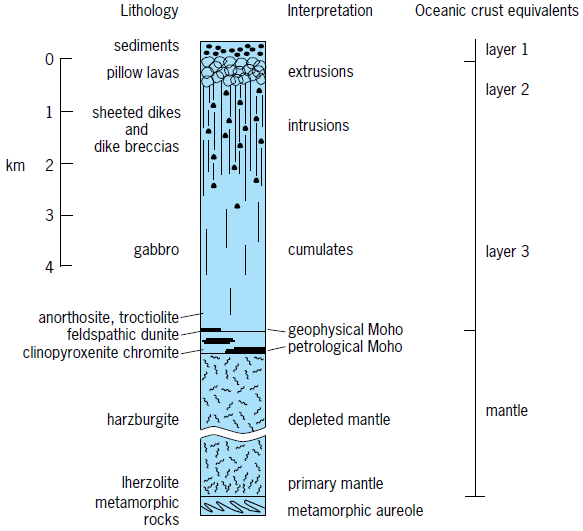
Nevertheless, the general seismic model of the ocean crust and the basic ophiolite model of crustal stratigraphy have generally been confirmed both by direct observation and by drilling. Sheeted dikes, for example, have been observed from submersibles on faulted exposures in both the equatorial Atlantic and eastern Pacific. Seismic velocities in the upper part of the ocean crust are consistent with the presence of pillow lavas or flows with many cracks and cavities. Velocities increase systematically with depth, indicating that this porosity structure diminishes, primarily because of compaction, filling of veins with alteration minerals, and transition to compact dikes. The deepest hole drilled in ocean crust, on the flank of the Costa Rica Rift in the eastern equatorial Pacific, reflects these relationships in downhole logging measurements through 1.8 km (1 mi) of igneous material. The transition to rocks with velocities of about 6.7 km/s (4.2 mi/s) is actually within the compacted dike sequence, and does not formally correspond to the lithologic transition to gabbros, which still has not been identified. See also: Petrology; Stratigraphy
Crustal formation
The composite lithology of gabbros, dikes, and extrusives forms ocean crust above the mantle in the following way. Gabbros comprise the frozen walls, roof, and floor of a spreading ridge's magma-chamber complex, which is more or less continuously supplied with magma from the upper mantle. The flux of magma, and thus the details of this process, differ according to whether the ridge is spreading rapidly or slowly, or is near an unusually hot region of mantle (that is, Iceland). The magma is supplied because of decompression melting of hot peridotite as it convects upward or rises diapirically into the region beneath the spreading ridge. Melts are driven out of the mantle rocks because they are under stress. While they are still molten, they coalesce, flow into fissures, and feed into the lower crust, where they cool and begin to crystallize. See also: Diapir; Hot spots (geology)
The steady-state process of seafloor spreading, however, requires that magmas be supplied to the lower crust nearly continuously. This forces magmas already residing in the crust out toward the surface. Elastic materials will initially respond to stress by bending or stretching, but not by breaking (similar to taffy or putty), in a process called ductile deformation. If the rate of stress is fast enough, then rocks will fracture under brittle deformation. At high temperatures (perhaps 600–700°C or 1100–1300°F), rocks will tend to experience only ductile deformation. At lower temperatures, they will more likely experience brittle failure. Earthquakes, in particular, are evidence for large-scale brittle failure at some depth in the crust or upper mantle.
Rocks in the uppermost crust, chilled by hydrothermal circulation of seawater, often experience brittle failure along vertical fractures under the combined impetus of upward magma injection and seafloor spreading. The tensional stress regime at spreading ridges determines that most fracturing will occur in a narrow zone parallel to the ridge (Fig. 7). Thus, dikes tend to be sheeted, and when these breach the sea floor, eruptions occur. Lava flows through dikes will be interrupted by more dikes as the ridge continues to spread, and repeatedly buried by younger flows after being carried to one side of the ridge or the other. Observations made from drilling and submersible instruments indicate that this process takes place perhaps 10–20 times in the course of building a given segment of crust at rifted, slowly spreading ridges such as the mid-Atlantic Ridge. Lava flows are often thinner along the much faster spreading East Pacific Rise and, therefore, more eruptive events may be required to build the same length of crust there. This speculation, though, has not yet been confirmed by drilling.
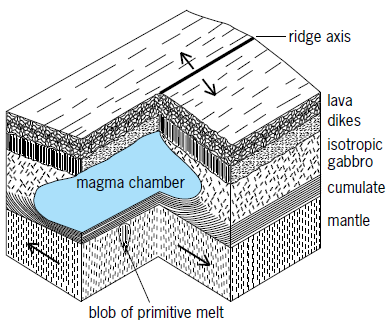
Coarse-grained gabbros crystallized from the magma chamber complex comprise approximately two-thirds of ocean crust. They may exist as solids in the deep crust due to the hydrothermal processes acting at the top of the crust that cool the steady-state crystallizing mass to nearly 50°C (90°F) below the average temperature of magmas arriving from the mantle. This cooling mechanism will crystallize at least 50–70% of molten material at a fast-spreading ridge before it can erupt. At slowly spreading ridges, where magma is supplied more gradually, hydrothermal cooling drives crystallization in the deep crust almost to completion. At both rapidly and slowly spreading ridges, crystallization occurs by the plating out of minerals (olivine, plagioclase, and clinopyroxene) along the walls of intrusive bodies in the gabbroic mass, all within close range (a few kilometers) of the center of spreading. The crystallization forces changes in the compositions of melts and thus drives magmatic differentiation in the ocean crust. The sequence of liquid compositions produced by this process changes from olivine basalt, to titanium-rich ferrobasalt, to rarely erupted ferroandesites and dacites. The latter liquids often remain in the lower crust, crystallizing to oxide-rich gabbro and plagiogranite. Occasionally, at slowly spreading ridges, rift dynamics will allow normal faults to penetrate the bodies of crystallizing magma-chamber complexes. This produces shear zones along which melts may migrate. Thus, dredged and drilled gabbroic rocks from these environments are often lithologically complex. While the deformed rocks may be highly sheared, with gneissic or porphyroclastic textures, they are often cut by younger veins of oxide gabbro or granitic material. See also: Dacite; Gabbro; Gneiss; Olivine
The fundamental melt product at mid-ocean ridges is variously termed abyssal tholeiite or mid-ocean-ridge basalt. In most places, this parental material is remarkably uniform in its fundamental petrologic and geochemical properties. Thus, it has a consistent crystallization sequence from place to place, and in most areas possesses depleted isotopic and trace-element signatures. The source of most abyssal tholeiites is a vast, globally distributed shallow mantle reservoir that previously experienced partial melting (thus losing radioactive parents to the radiogenic isotopes) at some distant time in the geological past. Currently, most tholeiites are experiencing further partial melting. There are places along spreading ridges, however, where less depleted or even enriched basaltic lavas are erupting. Most of these are in elevated, hot-spot regions such as Iceland and the Azores in the North Atlantic, Bouvet in the South Atlantic, Reunion in the Indian Ocean, and Easter Island in the Pacific. The ocean crust near these islands tends to be both shallower and thicker than average, in addition to being composed of isotopically distinctive basalts. The general processes of crustal accretion at these places, though, are approximately the same as elsewhere in the ocean crust. See also: Earth; Fault and fault structures; Isostasy; Structural geology; Subduction zones





